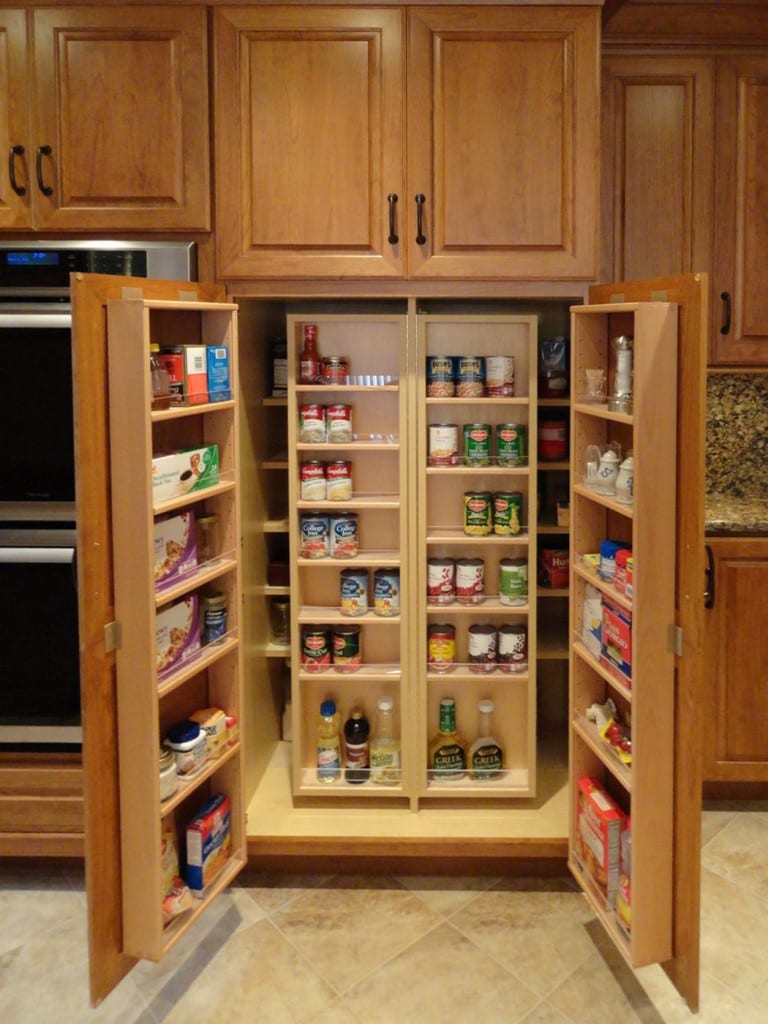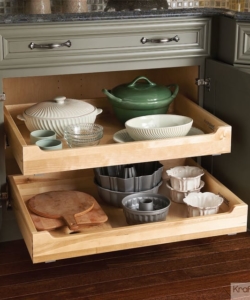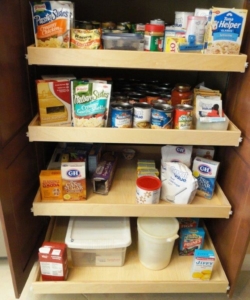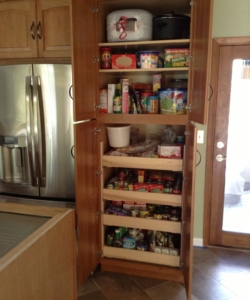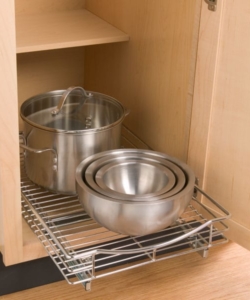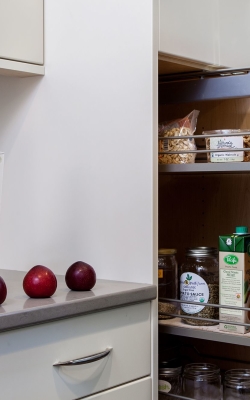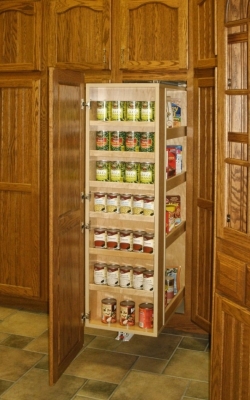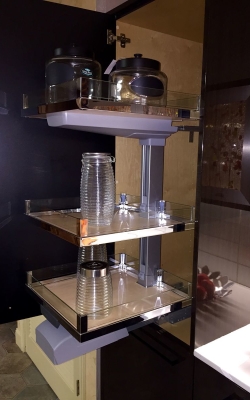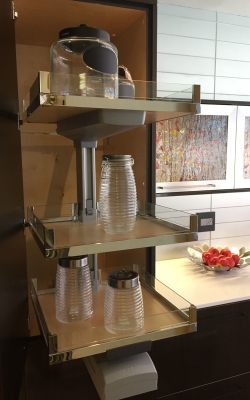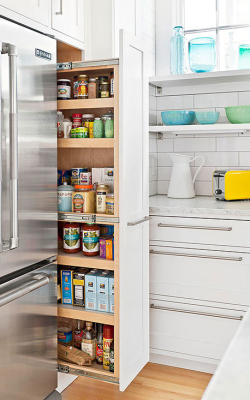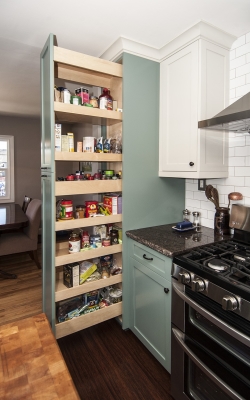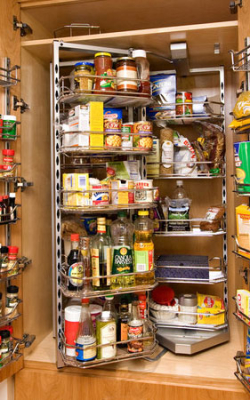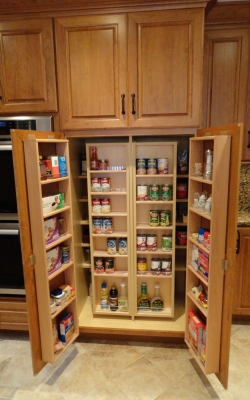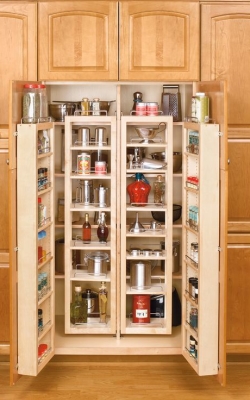If you’re like most homeowners, there’s never enough storage space for food items and other consumables in your kitchen. At a time when Costco and Sam’s Club have redefined the notion of “buying in bulk”, finding a place to store and easily access cans, cartons, bottles and boxes can be a challenge.
“Kitchen pantry” tends to be the catch-all phrase that suggests where these goods are stored in a kitchen. As we’ll discuss, this isn’t your grandmother’s kitchen pantry any more!

A Brief History of the Kitchen Pantries and Pantry Cabinets
If you’re of a certain age, (i.e. you remember when TV was defined by a dozen channels) the term kitchen pantry brings to mind something akin to a closet with shelves lining two or three walls from floor to ceiling. A pantry was a walk-in space where canned and boxed goods, paper towels, and other non-perishables were often stored.
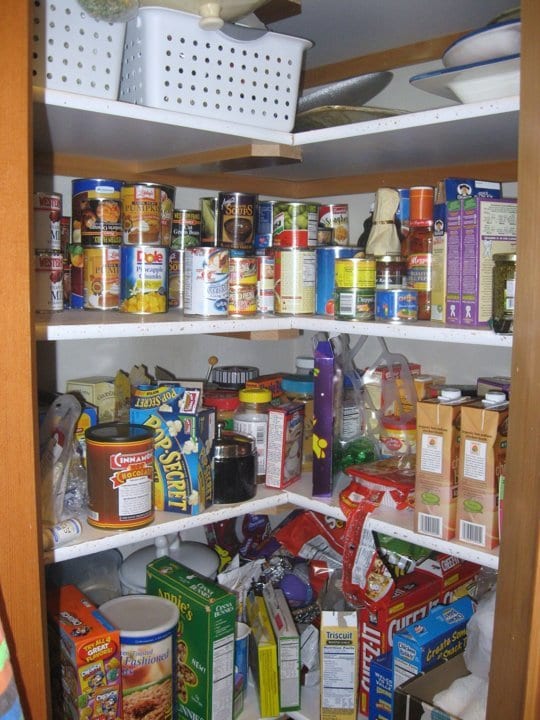
While the amount of square footage could be prodigious, pantries of the early to mid-1900’s often wasted space – space that became increasingly valuable as homeowners demanded ever-larger kitchens.
By the 1970’s walk-in pantries were largely gone from kitchen design and the lost storage was replaced by expanded base and wall cabinetry. Often 24” to 30” deep, kitchen cabinets could be packed with row after row of cans, boxes and bottles without sacrificing any of the walkway space required by pantry closets.
The problem with typical cabinetry storage, of course, was that it was nearly impossible to know what was lurking behind the first row or two of items. Indeed, you often needed to pull out half of the cabinet’s contents to even get a peek at what might be hiding in the back.
Within the past decade or so we’ve seen a revolution in the concept of pantry storage with innovative ideas matched to improved kitchen design and technology bringing about a more rational approach to pantry storage. Some of the solutions can retrofit and improve the functionality of existing kitchen cabinets. More often, the most innovative pantry cabinets will need to be designed into a remodeled or new kitchen.
Here is our take on alternative kitchen pantry storage solutions.
Vertical Storage attached to Cabinet Doors
One of the simplest and least expensive retrofit solutions is adding a two or three inch deep vertical rack to the door of a cabinet. With improvements in the design and strength of hinges, cabinet door-mounted storage has even become a design feature specified in many new kitchens.

Pluses:
- Least expensive solution
- Can be retrofit to existing cabinetry
- Shelf height can be easily adjusted
Minuses:
- Retrofit solutions often exceed the capabilities of existing hinges
- Limited utility on smaller cabinet doors
- Extra care needed when opening doors to avoid spills and tousled items
Base Cabinetry Roll Out Shelves and Drawers
One of the simplest ways to improve the ability of base cabinetry to effectively store pantry items are roll-out shelves and drawers. By allowing the shelves or drawers to pull out into the room, it’s much easier to see and manipulate stored items that would otherwise have been hidden.
- Low to moderate expense
- Can be retrofit to existing cabinetry
- Provides easier access to items in deep cabinets
- Sometimes cannot hold heavy loads
- Stored items mostly visible from the top
- Tend to be less durable over time
- Shelf height for designed-in roll-outs cannot be easily adjusted
Vertical Pull-out Pantries
Born in European cabinetry design but quickly adopted by US cabinet manufacturers, the vertical pull-out pantries are ubiquitous in today’s kitchen design. Their popularity is not surprising as no storage solution offers a better view of each and every item while also maximizing the use of space. Pluses:- Exceptional access to stored items
- Can carry heavy loads
- Can be utilized from floor to ceiling
- Can be expensive
- Vertical distances between shelves is difficult to adjust
- Poorly designed or manufactured units can fail and are costly to repair
Chef’s Pantries
The ultimate solution for the cook who wants their storage meticulously organized, the Chef’s pantry is a custom-designed solution with multiple panels of articulated vertical storage that can be rotated to reveal additional storage behind. Pluses:- Provides the highest level of organization for the serious cook
- Works well with deep cabinetry
- Easily adjustable shelving height
- Can be expensive
- Does not maximize the use of the available space
- Articulating vertical panels can cumbersome
Finding the Right Pantry Cabinet Solution for Your Home
It’s likely that if you’re building a new kitchen, or remodeling an existing one, your kitchen designer will incorporate a combination of these solutions to satisfy your unique pantry storage needs. This is where partnering with the right designer can make a huge difference in the utility, longevity and appearance of your dream space. The optimal pantry cabinet solution requires an understanding how you and those you love will live in the home. For example, floor to ceiling vertical pantries can be very heavy when fully loaded and if you’ve got young ones, or older family members, might not be the right solution. For safety and ease-of-access you might choose pull-out shelves or drawers in the base cabinetry so that everyone can easily access stored goods. We’ve just touched the surface with this overview of pantry storage and cabinets. If you’ve got questions, call us or click the chat button on the right. We’d be happy to help!- Why NKBA Design Certifications Matter Alot, Until They Don’t - September 3, 2024
- 2024 Kitchen & Bath Design Trend: Texture - April 9, 2024
- Why We Love Microwave Drawers for a Kitchen Remodeling Project - March 2, 2024

